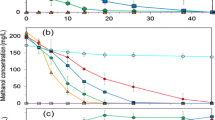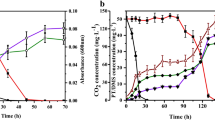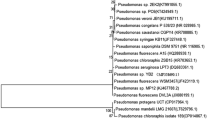Abstract
A Pseudomonas sp. strain WL2 that is able to efficiently metabolize ethyl mercaptan (EM) into diethyl disulfide (DEDS) through enzymatic oxidation was isolated from the activated sludge of a pharmaceutical wastewater plant. One hundred percent removal of 113.5 mg L−1 EM and 110.3 mg L−1 DEDS were obtained within 14 and 32 h, respectively. A putative EM degradation pathway that involved the catabolism via DEDS was proposed, which indicated DEDS were further mineralized into carbon dioxide (CO2), bacterial cells, and sulfate (SO4 2−) through the transformation of element sulfur and ethyl aldehyde. Degradation kinetics for EM and DEDS with different initial concentrations by strain WL2 were evaluated using Haldane-Andrews model with maximum specific degradation rates of 3.13 and 1.33 g g−1 h−1, respectively, and maximum degradation rate constants of 0.522 and 0.175 h−1 using pseudo-first-order kinetic model were obtained. Results obtained that aerobic degradation of EM by strain WL2 was more efficient than those from previous studies. Substrate range studies of strain WL2 demonstrated its ability to degrade several mercaptans, disulfides, aldehydes, and methanol. All the results obtained highlight the potential of strain WL2 for the use in the biodegradation of volatile organic sulfur compounds (VOSCs).




Similar content being viewed by others
References
An TC, Wan SG, Li GY, Sun L, Guo B (2010) Comparison of the removal of ethanethiol in twin-biotrickling filters inoculated with strain RG-1 and B350 mixed microorganisms. J Hazard Mater 183:372–380
Andrews JF (1968) A mathematical model for the continuous culture of microorganisms utilizing inhibitory substrates. Biotechnol Bioeng X:707–723
Arellano-Garcia L, Gonzalez-Sanchez A, Baquerizo G, Hernandez-Jimenez S, Revah S (2010) Treatment of carbon disulfide and ethanethiol vapors in alkaline biotrickling filters using an alkaliphilic sulfo-oxidizing bacterial consortium. J Chem Technol Biotechnol 85:328–335
Barbosa VL, Burgess JE, Darke K, Stuetz RM (2002) Activated sludge biotreatment of sulphurous waste emissions. Rev Environ Sci Biotechnol 1:345–362
Barreiros L, Nogales B, Manaia CM, Ferreira ACS, Pieper DH, Reis MA, Nunes OC (2003) A novel pathway for mineralization of the thiocarbamate herbicide molinate by a defined bacterial mixed culture. Environ Microbiol 5:944–953
Barreiros L, Fernandes A, Silva Ferreira AC, Helena P, Bastos MMSM, Manaia CM, Nunes OC (2008) New insights into a bacterial metabolic and detoxifying association responsible for the mineralization of the thiocarbamate herbicide molinate. Microbiology 154:1038–1046
Charlson RJ, Lovelock JE, Andreae MO, Warren SG (1987) Oceanic phytoplankton, atmospheric sulphur, cloud albedo and climate. Nature 326:655–661
Gould WD, Kanagawa T (1992) Purification and properties of methyl mercaptan oxidase from Thiobacillus thioparus TK-m. J Gen Microbiol 138:217–221
Hao OJ, Kim MH, Seagren EA, Kim H (2002) Kinetics of phenol and chlorophenol utilization by Acinetobacter species. Chemosphere 46:797–807
Hernandez J, Lafuente J, Prado OJ, Gabriel D (2012) Simultaneous removal of H2S, NH3, and ethyl mercaptan in biotrickling filters packed with poplar wood and polyurethane foam: impact of pH during startup and crossed effects evaluation. Water Air Soil Pollut 223:3485–3497
Kennes C, Rene ER, Veiga MC (2009) Bioprocesses for air pollution control. J Chem Technol Biotechnol 84:1419–1436
Li XS, Sato T, Ooiwa Y, Kusumi A, Gu JD, Katayama Y (2010) Oxidation of elemental sulfur by Fusarium solani strain THIF01 harboring endobacterium Bradyrhizobium sp. Microb Ecol 60:96–104
Monod J (1949) The growth of bacterial cultures. Annu Rev Microbiol 3:371–394
National Research Council of United States (N.R.C. U.S.) (2013) Acute exposure guideline levels for selected airborne chemicals: volume 15. The National Academies Press, Washington, DC, http://www.nap.edu/catalog.php?record_id=18449
Rappert S, Müller R (2005) Microbial degradation of selected odorous substances. Waste Manag 25:940–954
Saravanan P, Pakshirajan K, Saha P (2009) Batch growth kinetics of an indigenous mixed microbial culture utilizing m-cresol as the sole carbon source. J Hazard Mater 162:476–481
Sedighi M, Vahabzadeh F, Zamir SM, Naderifar A (2013) Ethanethiol degradation by Ralstonia eutropha. Biotechnol Bioproc Eng 18:827–833
Silambrasan S, Abraham J (2013) Kinetic studies on enhancement of degradation of chlorpyrifos and its hydrolyzing metabolite TCP by a newly isolated Alcaligenes sp. JAS1. J Taiwan Inst Chem Eng 44:438–445
Sipma J, Svitelskays A, Van Der Mark B, Hulshoff Pol LW, Lettinga G, Buisman CJN, Janssen AJH (2004) Potentials of biological oxidation processes for the treatment of spent sulfidic caustics containing thiols. Water Res 38:4331–4340
Staudinger J, Roberts PV (2001) A critical compilation of Henry’s law constant temperature dependence relations for organic compounds in dilute aqueous solutions. Chemosphere 44:561–576
Su Y, Xia FF, Tian BH, Li W, He R (2013) Microbial community and function of enrichment cultures with methane and toluene. Appl Microbiol Biotechnol 98:3121–3131
Wan SG, Li GY, An TC, Guo B, Sun L, Zu L, Ren AL (2010) Biodegradation of ethanethiol in aqueous medium by a new Lysinibacillus sphaericus strain RG-1 isolated from activated sludge. Biodegradation 21:1057–1066
Wan SG, Li GY, An TC, Guo B (2011) Co-treatment of single, binary and ternary mixture gas of ethanethiol, dimethyl disulfide and thioanisole in a biotrickling filter seeded with Lysinibacillus Sphaericus RG-1. J Hazard Mater 186:1050–1057
Zhang CZ, Zhang WJ, Xu J (2013) Isolation and identification of methanethiol-utilizing bacterium CZ05 and its application in bio-trickling filter of biogas. Bioresour Technol 150:338–343
Acknowledgments
The work was sponsored by the National High Technology Research and Development Program of China (No. 2012AA063102).
Author information
Authors and Affiliations
Corresponding authors
Electronic supplementary material
Below is the link to the electronic supplementary material.
ESM 1
(PDF 191 kb)
Rights and permissions
About this article
Cite this article
Wang, X., Wu, C., Liu, N. et al. Degradation of ethyl mercaptan and its major intermediate diethyl disulfide by Pseudomonas sp. strain WL2. Appl Microbiol Biotechnol 99, 3211–3220 (2015). https://doi.org/10.1007/s00253-014-6208-3
Received:
Revised:
Accepted:
Published:
Issue Date:
DOI: https://doi.org/10.1007/s00253-014-6208-3




